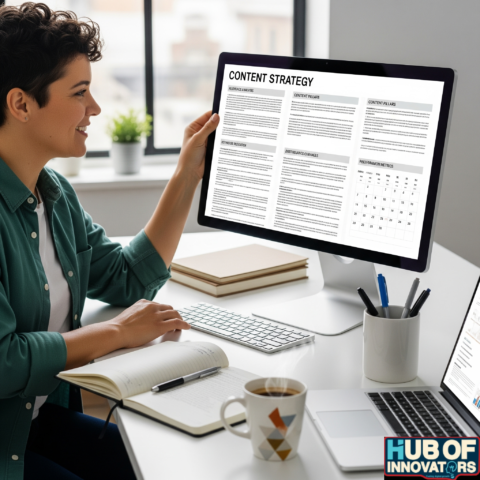In the current competitive global media environment, efficient media planning is essential for minimizing unnecessary ad expenses while enhancing brand awareness, engagement, conversions, and revenue – the key terms every marketer desires. Selecting the appropriate marketing channels to distribute top-performing content is essential for effective media planning, but achieving this can be more challenging than it seems.
Making an impact in a divided attention economy is difficult, as consumers switch between various devices, and industry studies suggest that almost half of digital advertising expenditures are ineffective. Failing to meet the target can significantly influence the outcome.
Let’s dive into it…
What is Media Planning?
Media planning is the strategic process of determining the most effective way to deliver your marketing message to your target audience. It’s more than buying ad space; it’s about understanding your audience’s media consumption habits, selecting the right channels, and optimizing your budget to maximize impact.
You might like this article: Here
Key Steps in the Media Planning Process:
- Define Objectives: Clearly outline your campaign goals. Are you aiming to increase brand awareness, drive sales, or generate leads?
- Understand Your Audience: Conduct thorough research to identify your target audience’s demographics, interests, behaviors, and media consumption patterns.
- Set Media Objectives: Determine the reach, frequency, and impact you want to achieve with your media plan.
- Media Selection: Choose the most suitable channels for your campaign, considering cost, reach, and audience overlap.
- Budget Allocation: Allocate your budget effectively across different channels and platforms.
- Campaign Implementation: Execute your media plan, monitor its performance, and adjust as needed.
- Evaluation and Optimization: Analyze your campaign results, identify improvement areas, and refine your strategy for future campaigns.

What is media buying?
Media buying is the process of purchasing advertising space or time on various media platforms, such as television, radio, print, digital websites, social media, and streaming services.
Essentially, it involves:
- Negotiating and acquiring ad placements: Securing the right spots for your ads at the best possible prices.
- Reaching the target audience: Ensuring your ads are seen by the specific group of people most likely to be interested in your product or service.
- Optimizing ROI: Maximizing the return on your advertising investment by effectively allocating your budget and achieving the desired campaign goals.
This article will help to understand what is ROI
Media planning vs media buying: what’s the difference?
Media Planning
- Focus: Strategic thinking and decision-making.
- Responsibilities:
Defining the target audience and their media consumption habits.
Setting campaign objectives (reach, frequency, impact).
Selecting the most suitable media channels (TV, radio, print, digital, OOH).
Developing media schedules and budgets.
Recommending the best media mix for achieving campaign goals.
Media Buying
- Focus: Execution and negotiation.
- Responsibilities:
Purchasing advertising space or time in the selected media channels.
Negotiating rates and securing the best deals with media vendors.
Managing the day-to-day operations of the media campaign.
Tracking campaign performance and making adjustments as needed.
Ensuring ads are delivered on time and according to the plan.

In essence:
Media planners create the roadmap, while media buyers drive the car.
Media planning is about strategy, while media buying is about tactics.
Both are crucial for the success of any advertising campaign, and they work closely together.
The Evolving Media Landscape
The digital age has revolutionized media planning, offering marketers a plethora of new channels and opportunities. Social media, search engine marketing, programmatic advertising, and influencer marketing have become integral parts of the media mix.
Key Considerations for Modern Media Planners:
- Data-Driven Decisions: Leverage data analytics to gain insights into audience behavior, track campaign performance, and optimize your media spend.
- Cross-Platform Integration: Develop integrated campaigns that seamlessly connect across multiple channels and platforms.
- Personalization: Tailor your messages to individual audience segments to enhance engagement and relevance.
- Measurement and Attribution: Track key metrics and attribute conversions to specific channels to understand the true ROI of your campaigns.
- Importance of Timing:
- Seasonality: Align campaigns with seasonal trends, holidays, and relevant events to maximize impact.
- Dayparting: Schedule ads during times when your target audience is most likely to be receptive (e.g., primetime TV, lunch breaks for social media).
- Creative Considerations:
- Message Matching: Ensure your creative assets (ads, videos, etc.) are tailored to the specific media channel and audience.
- Call to Action (CTA): Include clear and compelling CTAs that encourage desired actions (e.g., “Shop Now,” “Learn More,” “Sign Up”).
- Budgeting Strategies:
- Cost Per Mille (CPM): Pay per 1,000 impressions (views).
- Cost Per Click (CPC): Pay each time someone clicks on your ad.
- Cost Per Action (CPA): Pay for specific actions, such as conversions or leads.
- Emerging Trends:
- Audio Advertising: Explore the growing potential of podcasts, music streaming platforms, and in-car audio.
- Connected TV (CTV): Leverage the increasing popularity of streaming services for targeted video advertising.
- Artificial Intelligence (AI) in Media Planning: Utilize AI-powered tools for audience segmentation, campaign optimization, and predictive analytics.
- The Role of Media Agencies:
- Many businesses rely on media agencies to handle their media planning and buying needs.
- Agencies bring expertise, industry connections, and access to specialized tools and technologies.
Conclusion
Media planning is an ongoing process that requires continuous adaptation and innovation. By staying informed about the latest trends and technologies, marketers can effectively navigate the complex media landscape and deliver impactful campaigns that resonate with their target audience.








